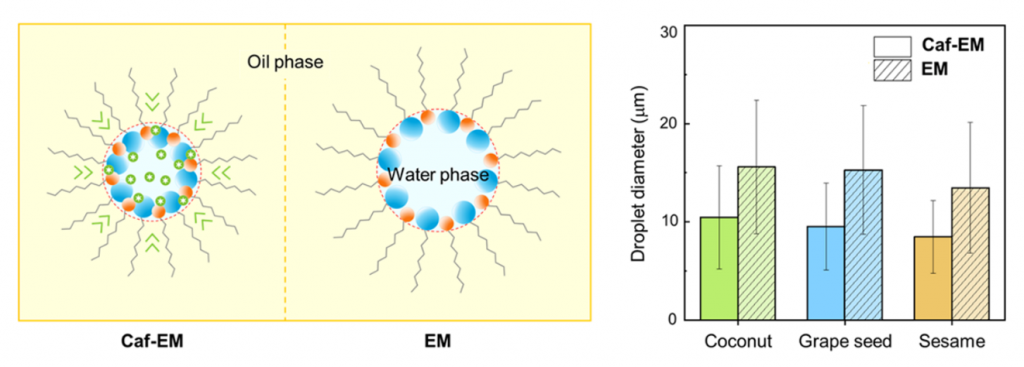This research uses a low-energy emulsification technique to create caffeine-containing emulsions, designated as Caf-EM. Coconut, sesame, and grape seed oils are employed alongside Span 80 and Tween 80 surfactants. We explore the impact of several factors, including (i) the hydrophilic-lipophilic balance (HLB) and surfactant proportion, (ii) the chemical composition of the oils, and (iii) the presence of caffeine, on the stability and size of the emulsions. Our findings reveal that the HLB value and surfactant proportion exert the most significant influence on emulsion stability. Optimal stability for Caf-EM is achieved by employing a blend of Span 80 and Tween 80 surfactants, with an HLB value of 6.4 at a concentration of 15% (S15-6.4) across all oil types. This specific ratio results in notably smaller emulsion droplet sizes than other ratios and consistently produces stable emulsions without caffeine (referred to as EM). Interestingly, formulation S15-6.4 induces a phase inversion from oil-in-water (O/W) to water-in-oil (W/O). Additionally, the presence of caffeine in the water phase contributes to forming smaller and more stable emulsions, with the particle size of Caf-EM approximately 1.5 times smaller than that of EM. Regarding the chemical composition of the oils, while there is a discernible trend in emulsion droplet size (coconut oil > grape seed oil > sesame oil), the differences within this sequence are insignificant, suggesting that the oil’s chemical composition has a limited effect on emulsion properties.

Keywords: | Caffeine, HLB, Mixing proportion, Chemical composition, Emulsion stability |
Reference: | Mekarun, J., Treepet, S., Rujiravanit, R., Theeramunkong, S., & Watthanaphanit, A. (2024). Caffeine-containing emulsion: Influence of the HLB and mixing proportions, the oil’s chemical composition, and the existence of caffeine on emulsion properties. ACS Omega, 9, 2, 2113–2122. https://pubs.acs.org/doi/10.1021/acsomega.3c03674 |
